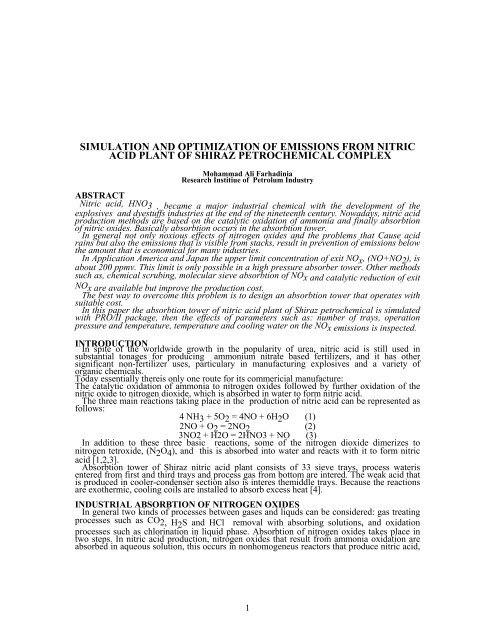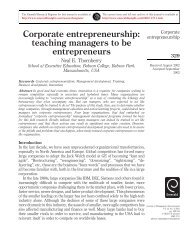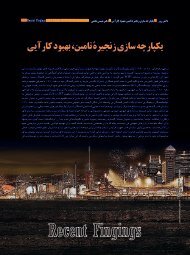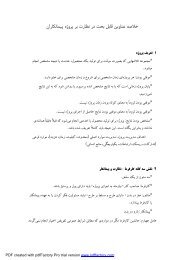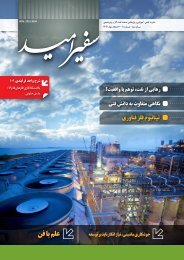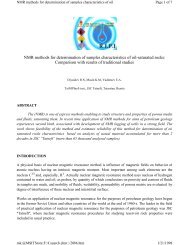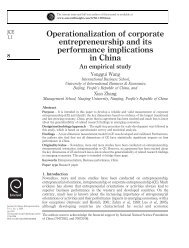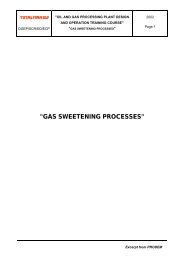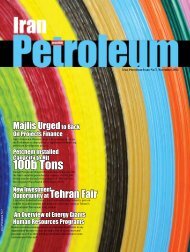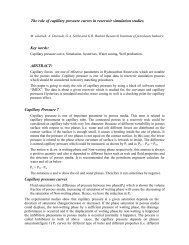simulation and optimization of emissions from nitric acid plant of ...
simulation and optimization of emissions from nitric acid plant of ...
simulation and optimization of emissions from nitric acid plant of ...
Create successful ePaper yourself
Turn your PDF publications into a flip-book with our unique Google optimized e-Paper software.
SIMULATION AND OPTIMIZATION OF EMISSIONS FROM NITRIC<br />
ACID PLANT OF SHIRAZ PETROCHEMICAL COMPLEX<br />
Mohammad Ali Farhadinia<br />
Research Institiue <strong>of</strong> Petrolum Industry<br />
ABSTRACT<br />
Nitric <strong>acid</strong>, HNO3 , became a major industrial chemical with the development <strong>of</strong> the<br />
explosives <strong>and</strong> dyestuffs industries at the end <strong>of</strong> the nineteenth century. Nowadays, <strong>nitric</strong> <strong>acid</strong><br />
production methods are based on the catalytic oxidation <strong>of</strong> ammonia <strong>and</strong> finally absorbtion<br />
<strong>of</strong> <strong>nitric</strong> oxides. Basically absorbtion occurs in the absorbtion tower.<br />
In general not only noxious effects <strong>of</strong> nitrogen oxides <strong>and</strong> the problems that Cause <strong>acid</strong><br />
rains but also the <strong>emissions</strong> that is visible <strong>from</strong> stacks, result in prevention <strong>of</strong> <strong>emissions</strong> below<br />
the amount that is economical for many industries.<br />
In Application America <strong>and</strong> Japan the upper limit concentration <strong>of</strong> exit NOx, (NO+NO2), is<br />
about 200 ppmv. This limit is only possible in a high pressure absorber tower. Other methods<br />
such as, chemical scrubing, molecular sieve absorbtion <strong>of</strong> NOx <strong>and</strong> catalytic reduction <strong>of</strong> exit<br />
NOx are available but improve the production cost.<br />
The best way to overcome this problem is to design an absorbtion tower that operates with<br />
suitable cost.<br />
In this paper the absorbtion tower <strong>of</strong> <strong>nitric</strong> <strong>acid</strong> <strong>plant</strong> <strong>of</strong> Shiraz petrochemical is simulated<br />
with PRO/II package, then the effects <strong>of</strong> parameters such as: number <strong>of</strong> trays, operation<br />
pressure <strong>and</strong> temperature, temperature <strong>and</strong> cooling water on the NOx <strong>emissions</strong> is inspected.<br />
INTRODUCTION<br />
In spite <strong>of</strong> the worldwide growth in the popularity <strong>of</strong> urea, <strong>nitric</strong> <strong>acid</strong> is still used in<br />
substantial tonages for producing ammonium nitrate based fertilizers, <strong>and</strong> it has other<br />
significant non-fertilizer uses, particulary in manufacturing explosives <strong>and</strong> a variety <strong>of</strong><br />
organic chemicals.<br />
Today essentially thereis only one route for its commericial manufacture:<br />
The catalytic oxidation <strong>of</strong> ammonia to nitrogen oxides followed by further oxidation <strong>of</strong> the<br />
<strong>nitric</strong> oxide to nitrogen dioxide, which is absorbed in water to form <strong>nitric</strong> <strong>acid</strong>.<br />
The three main reactions taking place in the production <strong>of</strong> <strong>nitric</strong> <strong>acid</strong> can be represented as<br />
follows:<br />
4 NH3 + 5O2 = 4NO + 6H2O (1)<br />
2NO + O2 = 2NO2 (2)<br />
3NO2 + H2O = 2HNO3 + NO (3)<br />
In addition to these three basic reactions, some <strong>of</strong> the nitrogen dioxide dimerizes to<br />
nitrogen tetroxide, (N2O4), <strong>and</strong> this is absorbed into water <strong>and</strong> reacts with it to form <strong>nitric</strong><br />
<strong>acid</strong> [1,2,3].<br />
Absorbtion tower <strong>of</strong> Shiraz <strong>nitric</strong> <strong>acid</strong> <strong>plant</strong> consists <strong>of</strong> 33 sieve trays, process wateris<br />
entered <strong>from</strong> first <strong>and</strong> third trays <strong>and</strong> process gas <strong>from</strong> bottom are intered. The weak <strong>acid</strong> that<br />
is produced in cooler-condenser section also is interes themiddle trays. Because the reactions<br />
are exothermic, cooling coils are installed to absorb excess heat [4].<br />
INDUSTRIAL ABSORBTION OF NITROGEN OXIDES<br />
In general two kinds <strong>of</strong> processes between gases <strong>and</strong> liquds can be considered: gas treating<br />
processes such as CO2, H2S <strong>and</strong> HCl removal with absorbing solutions, <strong>and</strong> oxidation<br />
processes such as chlorination in liquid phase. Absorbtion <strong>of</strong> nitrogen oxides takes place in<br />
two steps. In <strong>nitric</strong> <strong>acid</strong> production, nitrogen oxides that result <strong>from</strong> ammonia oxidation are<br />
absorbed in aqueous solution, this occurs in nonhomogeneus reactors that produce <strong>nitric</strong> <strong>acid</strong>,<br />
1
The next section <strong>of</strong> absorbtion tower is the gas treating section, the production <strong>of</strong> <strong>nitric</strong> <strong>acid</strong><br />
in this stage is very low.<br />
Because <strong>of</strong> complicated phenomena such as electrolytic solutions, absorbtion with chemical<br />
reactions <strong>and</strong> transfer phenomena, an emprical examination to optimize absorbtion tower<br />
<strong>from</strong> NOx <strong>emissions</strong> <strong>and</strong> material consumption point <strong>of</strong> view[6].is needed.<br />
OXIDATION AND ABSORBTION OF NITROGEN OXIDES IN HIGH PRESSURE<br />
Nitric <strong>acid</strong> is produced <strong>from</strong> absorbtion <strong>and</strong> reaction <strong>of</strong> nitrogen dioxide (NO2), with water.<br />
Absorbtion stage happens at ahigher pressure than oxidation <strong>of</strong> ammonia. Higher pressure <strong>and</strong><br />
lower temperature enhance the reaction. In absorbtion tower the following reactions occur:<br />
NO + 1/2O2 NO2 (4)<br />
2NO2 N2O4 (5)<br />
N2O4 + H2O HNO2 + HNO3 (6)<br />
3HNO2 HNO3 + 2NO + H2O (7)<br />
By addition <strong>of</strong> the two last reactions, the production <strong>of</strong> <strong>nitric</strong> <strong>acid</strong> formula is gained:<br />
3NO2 + H2O 2HNO3 + NO (8)<br />
The equilibrium constants <strong>of</strong> this reaction are: [7]<br />
K= (PNO * a 2 HNO3) / (P 3 NO2 * aH2O) = K1*K2<br />
K1=F1 (gas composition in equilibrium) K2= F2 (concentration <strong>of</strong> <strong>acid</strong> in liquid phase)<br />
P NO = partial pressure <strong>of</strong> NO in gas P NO2 = Partial pressure <strong>of</strong> NO2 in gas<br />
a HNO = activity <strong>of</strong> <strong>acid</strong> in liquid phase<br />
3 a H2O = activity <strong>of</strong> water in liquid phase<br />
SIMULATION OF ABSORBTION TOWER<br />
Absorbtion tower is simulated based on the following reactions:<br />
NO + 1/2O2 NO2 (gas phase) (9)<br />
2NO2 N2O4 (gas phase) (10)<br />
3NO2 + H2O 2HNO3 + NO (gas <strong>and</strong> liquid phase) (11)<br />
3/2N2O4 + H2O 2HNO3 + NO (gas <strong>and</strong> liquid phase) (12)<br />
In this model Ten theoretical trays for production <strong>of</strong> <strong>acid</strong> <strong>and</strong> five for treating <strong>of</strong> the exit gas<br />
are considered. Also theare considered in the seven lower trays, cooling coil for absorbing<br />
excess heat are considered.<br />
RESULTS OF SIMULATION AND OPTIMIZATION<br />
EFFECT OF PRESSURE ON ABSORBTION AND NOx EMISSION<br />
As mentioned, the important factor is the control <strong>of</strong> NOx emission. After absorbtion <strong>of</strong><br />
process gas, exit gas <strong>from</strong> the top <strong>of</strong> absorbtion tower has some quantity <strong>of</strong> nitrogen oxide <strong>and</strong><br />
nitrogen dioxide. According to the international st<strong>and</strong>ards the upper limit tar Nox emission is<br />
200ppm that is equal to 0.02 percent.,In this condition the absortion efficiency is almost 100<br />
percent. If we consider the stoichiometric equation <strong>of</strong> <strong>nitric</strong> <strong>acid</strong> production with respect to 50<br />
percent excess air, we have 20 mole emission gas for every mole <strong>of</strong> <strong>acid</strong> produced,. Since we<br />
have 400 kilomol <strong>acid</strong> per hour we will have 8000 kilomole emission gas per hour. Figure 1<br />
shows that operating pressure above 9 kg/cm2 provides the desired limit.<br />
EFFECT OF NUMBER OF TRAYS ON NOx EMISSION<br />
Figure 2 shows the concentration <strong>of</strong> NOx versus number <strong>of</strong> theoretical trays. According to<br />
this figure the concentration <strong>of</strong> NOx is reduced with increasing number <strong>of</strong> trays <strong>and</strong> after tray<br />
number ten on wards is actually negligible.<br />
2
Figure.1 Effect <strong>of</strong> pressure NOx emission<br />
Figure 2 Effect <strong>of</strong> number <strong>of</strong> Trays on NOx emission<br />
EFFECT OF TEMPERATURE AND COOLING ON ABSORBTION<br />
Oxidation rate <strong>of</strong> nitrogen monoxide is seriously dependeut on temperature,When the<br />
temperature increases the rate <strong>of</strong> NO oxidation decreases (dv to enegative temperature<br />
coefficient).<br />
The design <strong>of</strong> tower is in such a manner that in different seasons according to the temperature<br />
<strong>of</strong> process water temperature the emissiond NOx <strong>and</strong> produced <strong>acid</strong> Will be constant.<br />
However Figure 3 shows that with respect to limitations <strong>of</strong> operation <strong>and</strong> temperature <strong>of</strong><br />
3
process water, for every 1 MKCa l/hr cooling the tower, the production <strong>of</strong> <strong>acid</strong> will increase<br />
about 3 kmol/hr. This means that the NOx emission will decrease by 3kmol/her.<br />
Figure.3 Effect <strong>of</strong> cooling on HNO3 produced<br />
CONCLUSION:<br />
Simulation packages have their own advantages. With help <strong>of</strong> PRO/II package <strong>and</strong> aids <strong>of</strong><br />
simple assumptions <strong>and</strong> different sovrces, the absorbtion tower <strong>of</strong> <strong>nitric</strong> <strong>acid</strong> <strong>plant</strong> is<br />
simulated. After that the effects <strong>of</strong> different operating parameters on NOx emission is<br />
investigated. It is concluded that the most important parameter in controling the NOx<br />
emission is the operating pressure.<br />
REFERENCES:<br />
1. BRADLY J.K. AND DRAKE G.,CHEMICAL AGE OF INDIA, JAN. 1982, VOL.33,<br />
NO.1, PP.9-25.<br />
2. . CUTIERREZ C., etal., COMPUTER AND CHEMICAL ENGINEERING, SEPT.1989,<br />
VOL.13, NO.9, PP.985-1002.<br />
3. . NITROGEN NO.188, NOVEMBER-DECEMBER 1990. (LIBRARY OF<br />
PETROCHEMICAL COMPANY)<br />
4. . OPERATIONAL MANUAL OF PLANT.<br />
5. . PRO/II KEYWORD INPUT MANUAL.<br />
6. . RIGGEL , S HANDBOOK OF INDUSTRIAL CHEMISTRY.<br />
7. . ULLMAN , S ENCYCLOPEDIA OF INDUSTRIAL CHEMISTRY, 1991, A17 PP.293-<br />
339.<br />
4


